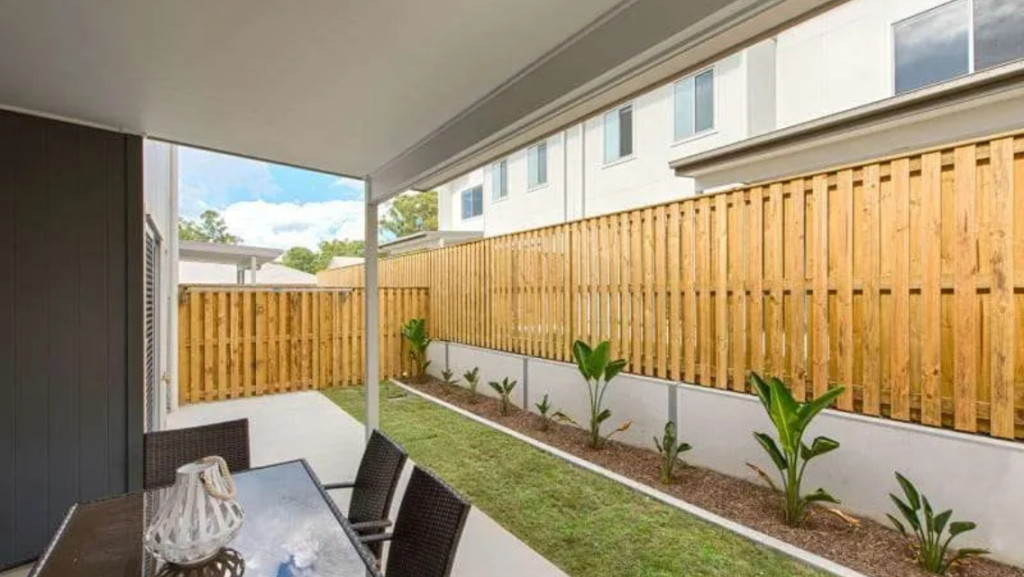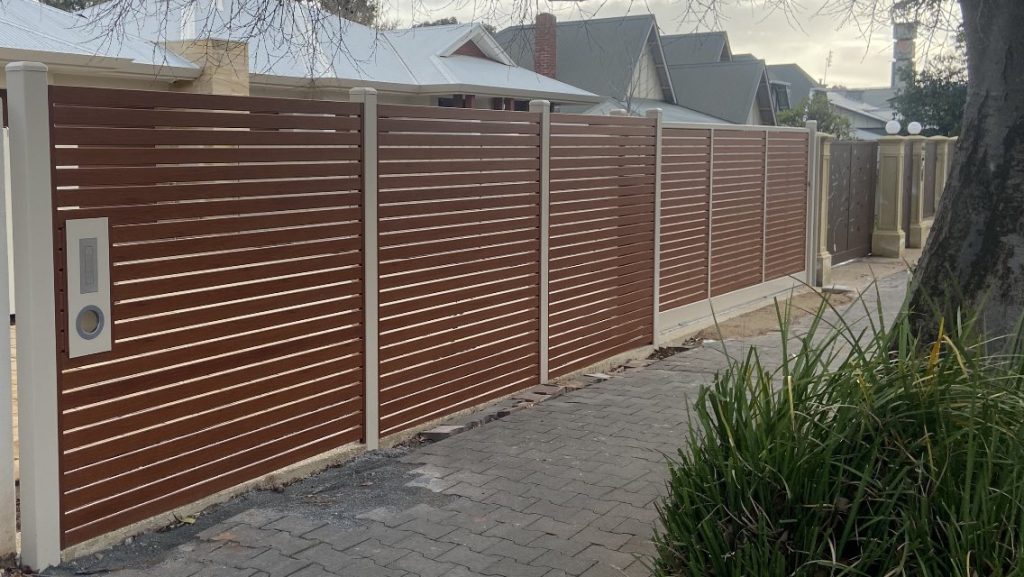
When deciding between a timber fence and a Colorbond fence for your Wollongong property, it’s crucial to weigh the pros and cons of each option.
As an experienced fencing contractor, I’ve worked on numerous residential and commercial projects, including timber, Colorbond, aluminium, and pool fencing.
This guide will help you make an informed decision tailored to your needs.
Table of Contents
- Timber Fences: Benefits and Considerations
- Colorbond Fences: Benefits and Considerations
- Comparative Analysis: Timber vs. Colorbond
- Environmental Impact
- Cost Considerations

Choosing the right fence for your property is an important decision. A timber fence brings a classic look, while a Colorbond fence offers modern durability. This guide explores the benefits and drawbacks of both, helping you decide the best fit for your Wollongong home or business.
Timber Fence: Benefits and Considerations
Aesthetic Appeal
Timber fences bring a classic, natural charm that can complement both traditional Queenslander homes and contemporary designs.
Examples:
A white picket timber fence paired with a weatherboard house exudes a quintessential Australian feel.
Stained hardwood fences can highlight the natural grain, enhancing the rustic beauty of bushland properties.
A tall timber slat fence can provide a stylish and private border for modern suburban homes.
Customisation
Timber offers unparalleled flexibility in terms of style, size, and finish.
Examples:
Homeowners can opt for louvre style timber slats to allow airflow while maintaining privacy.
Decorative designs, such as lattice or scalloped tops, can add a personalised touch.
Heights can range from low, decorative garden borders to tall boundary fences designed for privacy or security.
Durability and Maintenance
Timber fences require routine care to ensure longevity, especially in Australia’s varying climates.
Examples:
In tropical regions like Far North Queensland, regular application of anti rot treatments can prevent decay caused by high humidity.
For areas prone to termites, such as the Northern Territory, homeowners should use treated timber or apply termite resistant coatings.
Seasonal tasks like repainting or resealing can protect against UV damage and prolong the fence’s lifespan.
Environmental Impact
Timber is an eco friendly material, provided it is responsibly sourced.
Examples:
Look for certifications like the Forest Stewardship Council (FSC) to ensure sustainable timber sourcing.
Offcuts and aged fences can be repurposed into mulch or rustic furniture.
Opting for fast growing timber species, such as pine, can minimise environmental strain compared to slow growing hardwoods.
Timber Fence: Benefits and Considerations
Modern Design
Colorbond fences cater to sleek and contemporary tastes, available in over 20 colour options.
Examples:
Popular colours like Monument or Surfmist can match the neutral tones of modern Australian homes.
Colour matching the fence to the roof or gutters can create a cohesive property aesthetic.
Adding lattice or slat extensions can offer a custom, upscale appearance while improving functionality.
Low Maintenance
The coated steel construction makes Colorbond fences nearly maintenance free.
Examples:
A simple hose down once or twice a year removes accumulated dirt or debris.
Unlike timber, there’s no need for painting or pest control treatments, saving time and effort.
Colorbond’s anti rust coating ensures longevity, even in salty coastal air.
Durability
Designed to endure Australia’s harsh weather conditions, Colorbond is a reliable choice in extreme environments.
Examples:
In cyclone prone areas like Northern Queensland, the interlocking panels resist high winds.
In coastal regions such as Wollongong, the anti corrosion properties prevent rusting caused by salt laden air.
Its fire resistant nature makes it a preferred option in bushfire zones.
Environmental Impact
Colorbond is a sustainable fencing solution due to its recyclability and efficient manufacturing processes.
Examples:
Using recycled steel in its production reduces the demand for virgin materials.
The longer lifespan of Colorbond fences decreases the frequency of replacement, reducing waste.
Opting for energy efficient paint coatings, such as Thermatech, can help regulate temperatures around the property.
Comparative Analysis: Timber vs. Colorbond
Aesthetics
Timber’s natural look versus Colorbond’s modern, uniform finish.
Examples:
Timber is ideal for rural or heritage homes where blending with the natural surroundings is a priority.
Colorbond suits urban homes with minimalist or industrial designs.
Maintenance
Timber requires more effort to maintain than Colorbond.
Examples:
A timber fence might need re staining every 2–3 years to protect against sun damage.
In contrast, a Colorbond fence may only need periodic cleaning to retain its original look.
Cost
Both options vary in initial and ongoing costs.
Examples:
Installing a timber fence can cost less upfront, with untreated pine being one of the cheapest options.
Over time, maintenance expenses, including paints, sealants, and labour, can make timber more expensive.
Colorbond fences have a higher initial cost but require virtually no additional expense after installation.
Durability
Durability depends on environmental conditions.
Examples:
A timber fence may weaken after prolonged exposure to rain in regions like Melbourne.
Colorbond’s resistance to warping, rust, and pests makes it the better option in challenging climates.
Environmental Impact
Both materials have eco friendly aspects.
Examples:
Sustainably harvested timber ensures minimal impact on forests, while its biodegradability reduces landfill waste.
Recycling Colorbond panels reduces carbon emissions and supports the circular economy.

Why Choose Us
- Expertise: Over years of experience in both residential and commercial fencing.
- Quality Materials: We use high quality, sustainable materials.
- Custom Solutions: Tailored fencing solutions to meet your specific needs.
- Professional Service: Reliable and professional installation services.
- Free Quotes: Contact us for a free, no obligation quote.
Both timber and Colorbond fences offer distinct advantages. Your choice should be based on your aesthetic preferences, maintenance capabilities, and budget. Timber provides a classic, customisable look with more maintenance, while Colorbond offers modern durability with minimal upkeep.
For more information or to request a free quote, please contact us today.
FAQs
Timber fences are crafted from natural wood, which gives them a traditional and timeless appeal. They can be customised with different stains, paints, or finishes to suit various home styles. However, timber requires regular maintenance to protect it from weathering, pests, and decay. On the other hand, Colorbond fences are made from steel coated with a protective layer, offering a sleek and modern look. They are pre coloured, available in a range of shades, and designed to withstand harsh Australian weather conditions. While timber is versatile in style, Colorbond excels in durability and low maintenance.
Colorbond fences are the better choice for coastal areas like Wollongong due to their exceptional resistance to salt air and corrosion. These fences are built to endure the challenges of coastal weather, including high humidity, salty winds, and occasional storms. Timber, while beautiful, is more prone to warping, rotting, and pest infestations in such environments. With Colorbond, you can enjoy a long-lasting, low-maintenance fence that maintains its appearance and strength, even in challenging coastal conditions.
Timber fences typically require maintenance every 1-2 years to ensure they remain in good condition. This involves reapplying a protective stain, oil, or paint to shield the wood from moisture and UV rays. You’ll also need to inspect the fence for signs of rot, pest damage, or loose boards and make repairs as needed. Without proper maintenance, timber can deteriorate quickly, especially in areas with high rainfall or humidity, leading to additional repair costs over time.
Yes, Colorbond fences are environmentally friendly in several ways. They are manufactured from steel, which is 100% recyclable, meaning the material can be reused multiple times without losing its quality. The manufacturing process minimises waste and emissions, aligning with sustainable practices. Additionally, their long lifespan and minimal maintenance reduce the need for frequent replacements or the use of chemicals, like paints or stains, which can be harmful to the environment.
Timber fences generally have a lower upfront cost, making them an appealing choice for those on a tight budget. However, they come with ongoing maintenance costs, including staining, painting, and potential repairs due to weather damage or pests. Colorbond fences are more expensive initially, but their durability and low maintenance needs make them a cost-effective option in the long term. Over time, the reduced upkeep and long-lasting nature of Colorbond can offset the higher initial investment.
Yes, timber fences are highly customisable and can be tailored to suit your preferences and property. You can choose the height, shape, and design, from picket-style to horizontal slats or even full privacy panels. Timber can also be stained or painted in various colours to match your home’s aesthetic. Decorative features like lattice tops, carved panels, or post caps can be added for a more personalised touch, making timber fences ideal for creative and unique designs.
Colorbond fences are built to last 20-30 years or more, making them an excellent long-term investment. Their steel construction is highly resistant to rust, corrosion, and weather damage, ensuring they remain sturdy and visually appealing for decades. Unlike timber, Colorbond doesn’t require painting or staining, and its protective coating resists fading and chipping. With proper installation and minimal care, a Colorbond fence can provide both functionality and style for many years.
